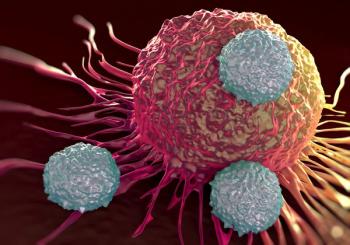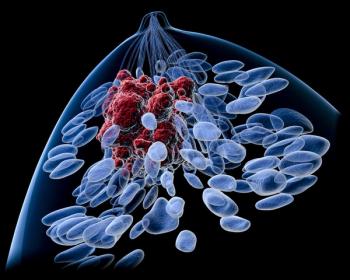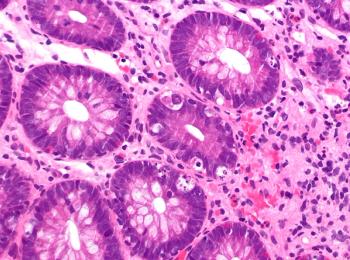
- ONCOLOGY Vol 16 No 5
- Volume 16
- Issue 5
Controversies in Early-Stage Hodgkin’s Disease
In their review of the history of the management of stage I/II Hodgkin’s disease, Drs. Ng and Mauch describe the results of various treatment protocols and outline the questions posed by ongoing European, Canadian, and American trials. In a broad sense, the questions posed by these trials will help clinicians understand the benefits and complications of these treatments. However, as clinically oriented as they are, the current studies have yet to answer some common problems faced by private practitioners-the clinicians who, in North America, manage most patients with Hodgkin’s disease.
In their review of the history of the management of stage I/II Hodgkin’sdisease, Drs. Ng and Mauch describe the results of various treatment protocolsand outline the questions posed by ongoing European, Canadian, and Americantrials. In a broad sense, the questions posed by these trials will helpclinicians understand the benefits and complications of these treatments.However, as clinically oriented as they are, the current studies have yet toanswer some common problems faced by private practitionersthe clinicians who,in North America, manage most patients with Hodgkin’s disease.
Staging Methods
Most investigators currently rely on computed tomography (CT) to evaluatepatients for the presence or absence of Hodgkin’s disease, and thelymphangiogram is only of historical interest to private practitioners. However,staging by positron-emission tomography (PET) scan is rapidly becoming routinepractice. Investigators, especially from European studies, have reported thevalue of this test in the management of aggressive lymphomas when performed byexperts; however, no large database has yet concluded that the PET scan is ofvalue in making treatment decisions for patients with Hodgkin’s disease. Bothtrue- and false-positives have been reported with this test; therefore, allclinicians must exercise caution when ordering a PET scan and should consider itancillary to CT and biopsy for confirmation of persistent or recurrent disease.
Investigators must better define the prognostic factors for Hodgkin’sdisease. As outlined by Ng and Mauch, ongoing studies have addressedhistorically valid factors for stage I/II Hodgkin’s disease. However,serologic studies have rarely been addressed in large-scale trials. Thesereproducible quantitative factors, including interleukin-10 (IL-10), solubleCD30, beta-2-microglobulin, and cellular expression of bcl-2, are indirectmeasurements of the biological activity of the disease, and may determine extentof disease, resistance to chemotherapy or radiotherapy, and the ultimatesurvival of patients with either early- or late-stage disease.[1-6]
Besides the studies mentioned by Ng and Mauch, other investigators have alsoused clinical features to address the problem of predicting outcome. TheInternational Prognostic Index (IPI) for advanced-stage disease has been appliedto the management of early-stage disease and may be useful in this setting.Other groups, basing their efforts on the early work of Specht, have attemptedto better measure tumor burden and the number of involved sites, especially foradvanced disease treated with chemotherapy.[7-12]
Investigators should further confirm the reproducibility and value of thesemethods. Nevertheless, in the hands of experienced investigators (includingacademic clinicians and private practitioners alike), these systems may identifypatients with very good and very poor prognoses when treated withcombined-modality therapy or chemotherapy alone.
Special Features
Four controversial unanswered questions about Hodgkin’s disease managementneed specific mentionie, treatment of the pregnant patient, the elderlypatient, the patient with lymphocyte-predominant disease, and the patient with aresidual mass after chemotherapy.
Management of the pregnant patient with Hodgkin’s disease has traditionallyinvolved radiation (as if the patient had early-stage disease), followed bydelivery of the infant, and classical staging or adjuvant therapy.[13] However,many drugs, including doxorubicin, bleomycin (Blenoxane), and vinblastine, canbe safely administered in the second- and third-trimester of pregnancy, andstudies should address the problem of chemotherapy delivery before, after, orwithout radiotherapy in this population, according to prognosticvariables.[14-17]
Management of the elderly patient with Hodgkin’s disease also remainssomewhat risky. Age is an adverse characteristic in most prognostic factormodels, including the IPI. Investigators designed most prognostic factor modelsfor advanced disease, and the best therapy for older patients with early-stagedisease has not been well addressed.[18] For example, older patients sometimescannot receive doxorubicin or bleomycin because of the presence or risk ofcardiac or pulmonary disease. Regardless of disease stage, the best chemotherapyregimen for these patients is unknown, since they may not be able to tolerateregimens more intensive than ABVD (doxorubicin [Adriamycin], bleomycin,vinblastine, dacarbazine [DTIC-Dome]), BEACOPP (bleomycin, etoposide,doxorubicin, cyclophosphamide [Cytoxan, Neosar], procarbazine [Matulane],prednisone), or Stanford V (mechlorethamine [Mustargen], doxorubicin,vincristine, vinblastine, etoposide, bleomycin, prednisone).
Lymphocyte-predominant Hodgkin’s disease may be easy to manage from theradiation oncologist’s viewpoint, as patients with early-stage disease achieveoutcomes similar to those of patients with early stages of other subtypes ofHodgkin’s disease.[19,20] But lymphocyte-predominant Hodgkin’s disease isalso exquisitely sensitive to the anti-CD20 monoclonal antibody rituximab(Rituxan).[21,22] In addition, rituximab may play a role in the treatment ofother types of Hodgkin’s disease, even those that do not express CD20, and thepossibility that it may potentiate the effects of both chemotherapy andradiotherapy in the treatment of these diseases is currently underinvestigation.[23]
Finally, management of the residual mass after treatment with chemotherapy isstill a controversial issue. Some investigators have shown that radiationtherapy may not be needed for patients receiving intensive chemotherapy.However, most European and American studies have included irradiation toinitially bulky or residual masses after adequate chemotherapy.[24] We needbetter methods of determining whether the residual mass is active disease(especially in the mediastinum), and whether administering adjuvant radiotherapyis of value.
Conclusions
Ng and Mauch have thoroughly detailed the questions asked by the ongoinglarge group trials. In particular, European studiesespecially those conductedby the European Organization for Research and Treatment of Cancer (EORTC) andthe German Hodgkin’s Lymphoma Study Group (GHSG)have very high accrualrates, and optimal therapy with minimal toxicity remains the main objective ofthese trials.
However, there are many other unanswered questions regarding the managementof early stages of Hodgkin’s disease, and the more discoveries made regardingthe biological diversity and behavior of this malignancy, the more questionswill arise. Both academic investigators and private practitioners should supportthe development and implementation of national and international trials toanswer the questions we face now and those we will face in the future.
References:
1. Vassilakopoulos T, Nadali G, Angelopoulou M, et al: Serum interleukin-10levels are an independent prognostic factor for patients with Hodgkin’slymphoma. Haematologica 86:274-281, 2001.
2. Sarris A, Viviani S, Bonfante V, et al: Serum IL-10 elevation andfailure-free survival of Hodgkin’s disease treated with radiotherapy.Haematologica 84:116, 1999.
3. Nadali G, Sarris A, Viviani S, et al: SCD30, progression-free survival(PFS) and survival (surv) in Hodgkin’s disease (HD) patients (pts) (abstract).Blood 94:514a, 1999.
4. Sarris A, Medeiros L, Rassidakis G, et al: Bcl-2 expression in Hodgkin’s-Reed-Sternbergcells (HRS) of patients (pts) with classical Hodgkin’s disease (CHD) isassociated with lower progression-free survival (PFS) and survival (abstract).Blood 96:725a, 2000.
5. Dimopoulos M, Cabanillas F, Lee J, et al: Prognostic role of serumbeta2-microglobulin in Hodgkin’s disease. J Clin Oncol 11:1108-1111, 1993.
6. Chronowski G, Wilder R, Tucker S, et al: Beta-2 microglobulin (B2M) is anadverse prognostic factor for overall survival in patients with early-stageHodgkin’s disease. Paper presented at: Fifth International Symposium onHodgkin’s Disease; September 22-25, 2001; Cologne, Germany.
7. Hasencleaver D, Diehl V: A prognostic score for advanced-stage Hodgkin’sdisease: International Prognostic Factors Project on Advanced Hodgkin’sDisease. N Engl J Med 339:1506-1514, 1998.
8. Franklin J, Paulus M, Lieberz D, et al: Is the international prognosticscore for advanced-stage Hodgkin’s disease applicable to early-stage patients?Ann Oncol 11:617-623, 2000.
9. Gobbi P, Zinzani P, Broglia C, et al: Comparison of prognostic models inpatients with advanced Hodgkin’s disease: Promising results from integrationof the best three systems. Cancer 91:1467-1478, 2001.
10. Sarris A, Santiago M, Preti A, et al: The number of involved sites (NIS)predicts failure-free survival (FFS) for adults with Hodgkin’s disease (HD)treated with ABVD or equivalent regimens. Blood 90(suppl 1):269b,
1997.
11. Gobbi P, Ghiradelli M, Solcia M, et al: Image aided estimate of tumorburden in Hodgkin’s disease: Evidence of its primary prognostic importance. JClin Oncol 19:1388-1394, 2001.
12. Specht L: Tumour burden as the main indicator of prognosis in Hodgkin’sdisease. Eur J Cancer 28:1982-1985, 1992.
13. Peleg D, Ben-Ami M: Cancer complicating pregnancy. Obstet Gynecol ClinNorth Am 25:365-383, 1998.
14. San Migud J, Lopez Borrasca A: Doxorubicin in the first trimester ofpregnancy. Ann Int Med 94:547, 1982.
15. Doll D, Ringenberg S, Yarbro J: Antineoplastic agents in pregnancy. SeminOncol 16:337-346, 1989.
16. Aviles A, Diaz-Maqueo J, Talavera A, et al: Growth and development ofchildren of mothers treated with chemotherapy during pregnancy: Current statusof 43 children. Am J Hematol 36:243-248, 1991.
17. Nantel S, Parboosingh J, Poon M: Treatment of an aggressive non-Hodgkin’slymphoma during pregnancy with MACOP-B chemotherapy. Med Pediatr Oncol18:143-145, 1990.
18. Kennedy BJ, Fremgen AM, Menck HR: Hodgkin’s disease survival by stageand age. J Am Geriatr Soc 48:315-317, 2000.
19. Wilder R, Jones D, Schlembach P, et al: EORTC-GPMC very favorable andfavorable lymphocyte predominant Hodgkin’s disease. Presented at 5thInternational Symposium on Hodgkin’s Lymphoma, Cologne, Germany, September22025, 2001.
20. Ha CS, Kavadi V, Dimopoulos MA, et al: Hodgkin’s disease withlymphocyte predominance: Long-term results based on current histopathologiccritieria. Int J Radiat Oncol Biol Phys 43:329-334, 1999.
21. Rehwald U, Engert A, Diehl V: Monoclonal anti-CD20 antibody rituximab(Rituxan) for treatment of CD20-positive Hodgkin’s lymphoma: The Germanexperience (abstract). Blood 96:729a, 2000.
22. Lucas JB, Hoppe RT, Horwitz SM, et al: Rituximab is active in lymphocytepredominance Hodgkin’s disease (abstract). Blood 96:831a, 2000.
23. Younes A, Romaguera J, Hagemeister F, et al: A pilot study of rituximabin patients with relapsed Hodgkin’s disease of classical type (abstract).Blood 96:733a, 2000.
24. Brice P, Colin P, Berger F, et al: Advanced Hodgkin’s disease withlarge mediastinal involvement can be treated with eight cycles of chemotherapyalone after a major response to six cycles of chemotherapy. Cancer 92:453-459,1992.
Articles in this issue
over 23 years ago
Promising New Treatment Option for Primary Bone Cancerover 23 years ago
Irinotecan, Cisplatin, and Radiation in Esophageal Cancerover 23 years ago
Irinotecan for the Treatment of Cervical Cancerover 23 years ago
Irinotecan in Epithelial Ovarian Cancerover 23 years ago
Combined-Modality Therapy for Rectal Cancer Using Irinotecanover 23 years ago
Future Directions in Adjuvant Therapy for Rectal CancerNewsletter
Stay up to date on recent advances in the multidisciplinary approach to cancer.

















































































